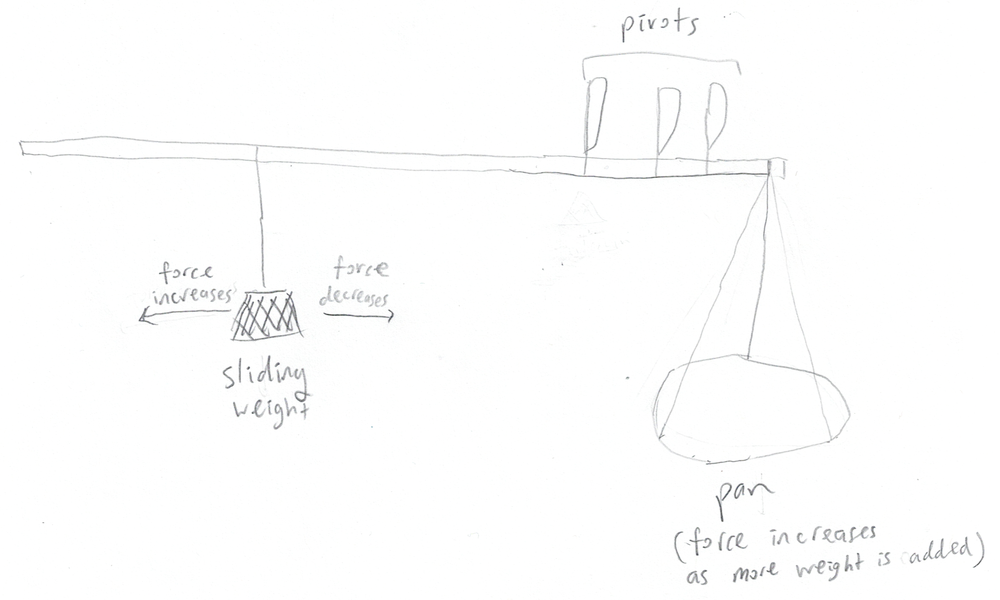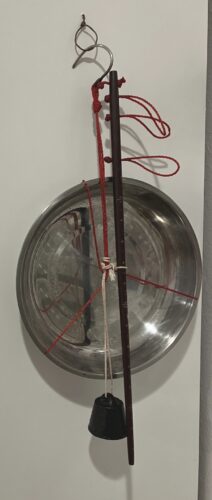Introduction
Last summer in Hong Kong I bought a steelyard scale from Lee Wo Steelyard on Shanghai street. When asked how to use the scale, the store owner told me to “ask my mom, she knows”, but she didn’t. I then consulted my grandfather, who gave a partial explanation of how to use the scale and read the weight. Aside from him though, nobody else (even among my Hong Kong relatives) knew exactly how to use it and read the weight. What would have helped me at the time is a specific English guide on Chinese steelyards, but since I could not find one online, I had to figure it out myself.
A Chinese steelyard scale has a beam, a pan, several pivot strings, and a sliding weight suspended from the beam on a string. It works on the principle of the first-class lever: the force applied by the pan on one side of the fulcrum is balanced out by the force applied by the sliding weight on the other. The farther away the sliding weight is from the fulcrum, the more force it imparts, even though its weight remains the same. Additionally, the multiple pivot strings allow for a wide range of weights to be measured; by placing the pivot closer to the pan the force produced by the pan is decreased, allowing heavier things to be balanced by the sliding weight — up to 10kg!

How to Use
General instructions (see featured image for demonstration):
- Place the item to be weighed in the pan.
- Lift the scale from one of the pivot strings with the RIGHT hand, with the pan towards the RIGHT.
- Adjust the weight with the LEFT hand until the scale balances.
- Read the weight of the object based on the position of the string on the beam.
This steelyard is graduated according to the Hong Kong mass units of catties (斤) and taels (兩), similar to pounds and ounces. Each catty is equivalent to 1 ⅓ pounds (604.7893g) and each tael is 1 ⅓ ounces (37.7993g). When the scale is lifted as instructed, it becomes clear that there are three sets of graduations on the front, top, and back of the beam: the front corresponds to the pivot farthest from the pan (used to measure the lightest objects), the top matches the middle pivot, and the back matches the pivot closest to the pan. The wooden beam is marked by drilling small holes and filling them with short lengths of brass wires, creating a durable and precise pattern of dots that allows quick reading of the weight.

Additional Information
The scale also has a hook attached at the same point as the pan that can be used for weighing bags. It can also be used to hang up the scale for storage.
To stow the scale, hold the scale by the beam at its halfway point at a 45° angle with the pan to the right and up, also pinching the weight so it does not fall. Using the right hand, bring the weight’s string over the pan’s strings once, pinching the three strings together. Move the left hand to pinch these strings in addition to the weight. Finally, wrap the weight around the pan strings twice more. You can now hang the scale from its hook. For an video of this, see here.

In days of yore, these simple scales were the standard measuring devices all over Hong Kong and China in markets, shops, etc. These days, they’ve largely been displaced by mechanical and digital scales which are more precise and easy to read. Now, you’d be hard-pressed to find them outside a Chinese medicine shop — and you don’t see them very much outside of China, either. Even the measurement system has changed: in mainland China, catties and taels are still used, but the government has (to their credit, in my opinion) changed their values to be compatible with the metric system: 500g per catty and 50g per tael. And finally, the art of scale-making is dying out. There is no financial incentive to learn this labor-intensive and hard-to-acquire craft. Perhaps CNC machining will one day be used to manufacture such devices to fill the small demand for which there is a dwindling supply. Personally, I appreciate this scale because it is simple, robust, works without a power source, and is easily cleanable, though it is slightly annoying that it uses traditional Chinese units instead of metric ones.
To that end, here’s a table of catty/tael-to-metric conversions specifically for this scale. It’s meant to be printed out.

